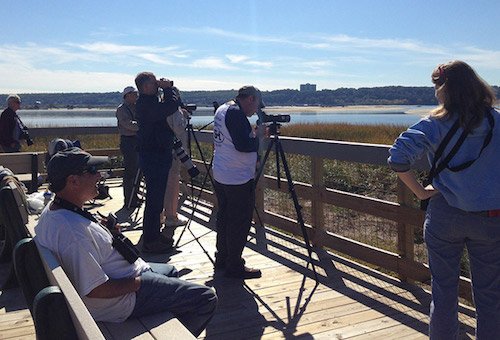Big Sits

Static Racing
It may seem a contradiction in terms but you can take part in bird races without charging around the countryside after weeks of planning in search of the longest list in a county. The alternative is to pick a spot and stay put for 24 hours to see how many birds come within range. The art is, of course, to find a spot likely to produce a long list and for this the range of habitats that can be viewed without relocating is likely to be key.
The Big Sit is, of course, much kinder to the environment and, dare we suggest it, kinder to the birds too. The countryside will be less disturbed, the atmosphere saved from yet more spent hydrocarbons and the ozone less effected by pollutants put out by nervous racers!
Of course this may just be the bias of the Fat Birder who always prefers to sit and wait for birds to come to him. Pure idleness may be my reason but the environmentalists can stick to their story; I will plead arthritis and a sedentary disposition.
Peter Wilkinson has been a leading proponent of the Big Sit and has been hoping that it will catch on in the UK. He (among others) set the scene in previous years and produced reports on both.
In 1999 the Sitting Ducks took to the field somewhere in Kent. Two of us three were eminent patch workers wanting to encourage this worthy pursuit – whilst I was, of course, not so much worthy as lazy.
Below are the rules currently suggested by Peter Wilkinson As they are very much based on the American rules why not suggest modifications and start a dialogue that will end in this event growing as big as the Big Race itself.
UK Big Sit Rules
(With grateful acknowledgement to the American Big Day Count Rules from which these rules are adapted)
A Big Sit is a single-team effort in which the primary objectives are (1) to identify as many bird species as possible during a single calendar day and (2) to strive to have all team members identify all species recorded. A UK Big Sit must be conducted in accordance with the following rules:
1. Area.
All counting must be conducted from within a circle with a diameter of no more than 17 feet whose centre is a single designated point.
2. Counting.
a. Count only full species as indicated by the current BOURC checklist, categories A to C only.
b. Birds must be conclusively identified by sight or sound. Use common sense: if in doubt about the bird’s identity, don’t count it. Identification may be confirmed after the original observation if that identification is based solely on field notes made while the bird was living and unrestrained. A bird identified to one of a species group (e.g. Common/Arctic Tern) may be counted as a species if no other in that group is counted.
c. Birds counted must be alive, wild and unrestrained. Birds attracted to feeders may be counted. Tape recorders may not be used. Injured birds may be counted if wild and unrestrained. Eggs do not count as birds. d. a species must be seen or heard by at least two team members to be counted in the team’s total.
3. Time.
a. All counting must be within a single 24-hour period, on a single day.
b. A time-out must be designated when less than two team members are in the defined circle. A bird first seen or heard during a time-out may not be counted until the timeout has come to an end and at least two team members are in the circle.
4. Participants.
a. A team may be composed between two and four members.
b. Non-participating companions may accompany the team but may not assist with the location or identification of birds not already counted by the team.
5. Conduct. Each team member must
a. make every reasonable effort to identify personally and to help other team members to identify every species counted by the team
b. count only birds personally and unquestionably identified
c. review the Big Sit rules and any local bye-rules applicable to the Big Sit being conducted before the start of the count.
6. Outside Information.
Where the location of the Big Sit is such that other birders may from time to time be within or in the immediate proximity of the defined circle (such as when the circle is within or includes a public hide); teams must make every reasonable effort to avoid receiving bird finding help from non-team members. Where despite precautions such assistance is nevertheless received, the team may use it.
7. Ethics.
Each team member and any non-participating companions must abide by the Birdwatchers Code of Conduct.
8. Bye-rules.
Any body organising a Big Sit in which more than one team will participate may make additional bye-rules applicable to the Big Sit being organised (e.g. covering site selection, time involved or team size) provided that such bye-rules do not conflict with the rules above.
Big sit rules were originally devised by the New Haven Bird Club.
